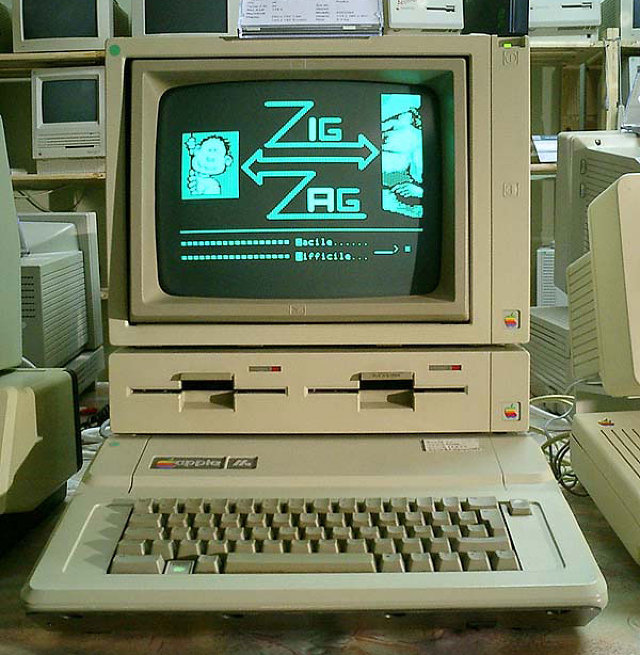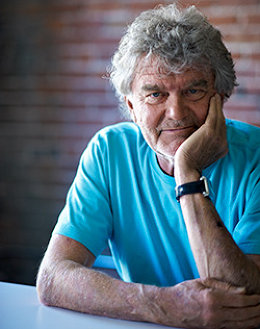How I Taught Steve Jobs To Put Design First
HARTMUT ESSLINGER, FOUNDER OF FROG AND CREATOR OF APPLE’S SNOW WHITE DESIGN LANGUAGE, RECOUNTS CONVINCING JOBS TO EMPOWER DESIGNERS.
My first encounter with Apple was at the ICSID World Design Congress in Helsinki in 1978, where the company had installed a working Apple IIe system. I liked Apple’s technology and price and how well these rudimentary products worked. Apple’s funny rainbow logo had the words “apple computer” scrawled across in an ugly typeface. As for product design, it looked like a clunky old typewriter without its ribbon and roller, and the keyboard stood at a wildly non-ergonomic height above the desktop. Two primitive 5 ¼–inch floppy disk drives made of generic sheet metal rested on top of the computer case, capped by an off-the-shelf Japanese monitor that displayed green characters on a black background. The Apple IIe clearly fell short of a grand vision, but I decided to buy one anyway. And as I played with my nice toy it dawned on me that computers—or “thinking machines”—were destined to enter our daily lives.

ON THE ROAD TO APPLE
My major consumer tech client at the time was Sony, which I believed had the technology to expand into personal computers. But after developing a few prototypes with Sony engineers, it was clear by 1981 that management wasn’t interested. I turned my attention to Silicon Valley: HP, for example, with its technologically advanced products, seemed to be a logical choice. Yet I eventually realized that HP’s DNA simply didn’t allow for introducing human-centered design to technology products. At that point I knew I had to get in touch with Apple.
That happened in an unusual way. In early 1982 I was in California talking to designers who might be interested in working with me. The meetings didn’t go anywhere, but the discussions brought home the realization that most designers in U.S. companies were in-house employees who reported to managers in marketing and engineering. Then one day I was at a party in Silicon Valley and met Rob Gemmell, the Chief Designer of the Apple II Division. After showing him my visual materials, Rob said, “You have to meet Steve Jobs. He is this crazy guy, but he really cares about world-class design and wants to bring it to Apple.”
THE REAL JOURNEY BEGINS
Rob visited our studio in Germany’s Black Forest and described a competition Apple was organizing between design agencies—which was fine with me. I was already convinced that working with Apple might be a life-changing opportunity for me. I clearly recognized the huge gap between the reality of Apple’s current products and Steve Jobs’ ambition to make his company “the world’s best.” We agreed that on my next trip to the U.S. I would visit Apple’s offices in Cupertino and meet Steve Jobs, who by coincidence would soon appear on the cover of TIME magazine with the headline “Striking It Rich.”
As I prepared for the meeting, I wondered what this mercurial man would be like and if he’d quickly kick me out of his office, as I had been warned. While waiting to see him, a rather formally dressed man came out of his office; this made me uneasy because I was clad in jeans, sneakers and a t-shirt. But when Steve emerged I noticed that his t-shirt was even older than mine. The previous visitor, Steve told me with a laugh, was California Governor Jerry Brown. “He’s looking for a job,” Jobs joked.
STEVE DIDN’T REALLY KNOW MUCH ABOUT DESIGN, BUT HE LIKED GERMAN CARS.That broke the ice, and I showed Steve some of my work, emphasizing the products I’d designed for WEGA and Sony. Almost immediately he said, “I want this for Apple.” We also spoke about process. I explained that to make design a core element of Apple’s corporate strategy, it would have to be seen as a leadership issue; world-class design can’t work its way up from the bottom, watered down by the motivations and egos of every layer of management it passes through. I also offered a number of examples of corporate designers—especially in the United States—who were being compromised by the need to report to lower levels. Steve looked a bit irritated when I told him that my initial observations of Apple’s design process revealed exactly the same pattern of structurally determined mediocrity.

That wasn’t the only strained moment of our conversation that day. Steve seemed astonished that I spent less time talking about my projects than I spent describing the objectives, goals, and processes of my approach to design, including my experiences navigating power struggles within my client’s companies— most of which resulted in very successful products. He seemed mildly uncomfortable with the idea that a design language isn’t universal or absolute but needs to be right for the spirit of a company, and I saw him frown when I said that aesthetics evoke emotions but are just one of the elements of a great product.
In fact, Steve didn’t really know much about design, but he liked German cars. Leveraging that connection, I explained that design like that has to be a complete package, that it must express the product’s very soul; without the excellent driving experience and the history of stellar performance, a Porsche would be just another nice car—but it wouldn’t be a Porsche. We also discussed American design, and I offended him when I insisted that American computer and consumer electronics companies totally underestimated the taste of American consumers—Sony’s success with clean design being the proof. He was gracious enough to concede that Apple didn’t make the cut, but he also said that he was out to change all that, which was why he was looking for a world-class designer.
When I asked him about his bigger ambitions, he simply smiled and said: “First, I want to sell a million Macs. Then I want Apple to become the greatest company on earth.” For some strange reason, we both agreed that those goals were absolutely achievable.
I URGED STEVE TO RETHINK APPLE’S EXISTING DESIGN PROCESS AND THE WAY IT PLACED DESIGNERS AT THE MERCY OF ENGINEERING.At the end of the meeting, I again urged Steve to rethink Apple’s existing design process and the way it placed designers at the mercy of engineering. I told him that, in my opinion, Apple needed one design leader and one team reporting directly to him, and design had to be involved years ahead of any actual product development in Apple’s strategic planning. With that framework in place, Apple could project new technologies and consumer interactions for years ahead, which would help avoid shortsighted ad-hoc developments.
Steve reluctantly promised that if frog won the competition, design would take a top position at Apple and report directly to him. I left his office that day feeling motivated and inspired, but also quite aware of the challenge we were taking on. My brief experience at Apple had convinced me that neither its division managers nor its designers would accept this change without a fight, and Steve had assured me the battle would be mine to win. Naturally, there were some points where we disagreed—Steve believed that “one insanely great product” would define Apple, whereas I insisted that Apple needed a comprehensive strategy that could generate a line of great products. But we launched a pivotal collaboration that day, creating what would become one of the most successful and influential designer/entrepreneur alliances in the history of consumer technology.